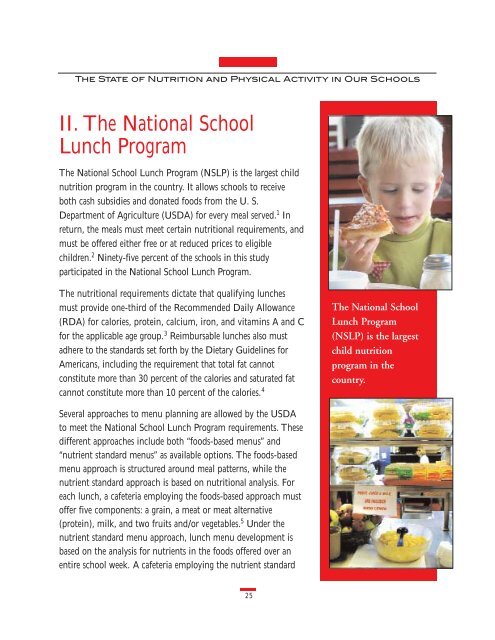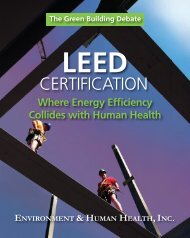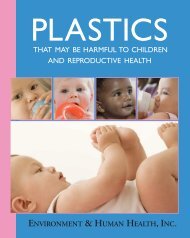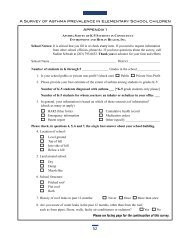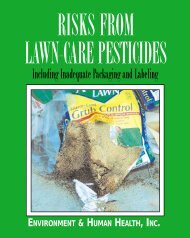nutrition and physical activity in our schools - Environment & Human ...
nutrition and physical activity in our schools - Environment & Human ...
nutrition and physical activity in our schools - Environment & Human ...
- No tags were found...
You also want an ePaper? Increase the reach of your titles
YUMPU automatically turns print PDFs into web optimized ePapers that Google loves.
The State of Nutrition <strong>and</strong> Physical Activity <strong>in</strong> Our SchoolsII. The National SchoolLunch ProgramThe National School Lunch Program (NSLP) is the largest child<strong>nutrition</strong> program <strong>in</strong> the country. It allows <strong>schools</strong> to receiveboth cash subsidies <strong>and</strong> donated foods from the U. S.Department of Agriculture (USDA) for every meal served. 1 Inreturn, the meals must meet certa<strong>in</strong> <strong>nutrition</strong>al requirements, <strong>and</strong>must be offered either free or at reduced prices to eligiblechildren. 2 N<strong>in</strong>ety-five percent of the <strong>schools</strong> <strong>in</strong> this studyparticipated <strong>in</strong> the National School Lunch Program.The <strong>nutrition</strong>al requirements dictate that qualify<strong>in</strong>g lunchesmust provide one-third of the Recommended Daily Allowance(RDA) for calories, prote<strong>in</strong>, calcium, iron, <strong>and</strong> vitam<strong>in</strong>s A <strong>and</strong> Cfor the applicable age group. 3 Reimbursable lunches also mustadhere to the st<strong>and</strong>ards set forth by the Dietary Guidel<strong>in</strong>es forAmericans, <strong>in</strong>clud<strong>in</strong>g the requirement that total fat cannotconstitute more than 30 percent of the calories <strong>and</strong> saturated fatcannot constitute more than 10 percent of the calories. 4The National SchoolLunch Program(NSLP) is the largestchild <strong>nutrition</strong>program <strong>in</strong> thecountry.Several approaches to menu plann<strong>in</strong>g are allowed by the USDAto meet the National School Lunch Program requirements. Thesedifferent approaches <strong>in</strong>clude both “foods-based menus” <strong>and</strong>“nutrient st<strong>and</strong>ard menus” as available options. The foods-basedmenu approach is structured around meal patterns, while thenutrient st<strong>and</strong>ard approach is based on <strong>nutrition</strong>al analysis. Foreach lunch, a cafeteria employ<strong>in</strong>g the foods-based approach mustoffer five components: a gra<strong>in</strong>, a meat or meat alternative(prote<strong>in</strong>), milk, <strong>and</strong> two fruits <strong>and</strong>/or vegetables. 5 Under thenutrient st<strong>and</strong>ard menu approach, lunch menu development isbased on the analysis for nutrients <strong>in</strong> the foods offered over anentire school week. A cafeteria employ<strong>in</strong>g the nutrient st<strong>and</strong>ard25


